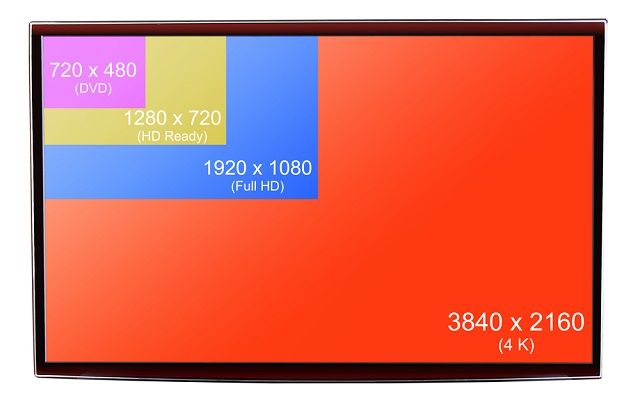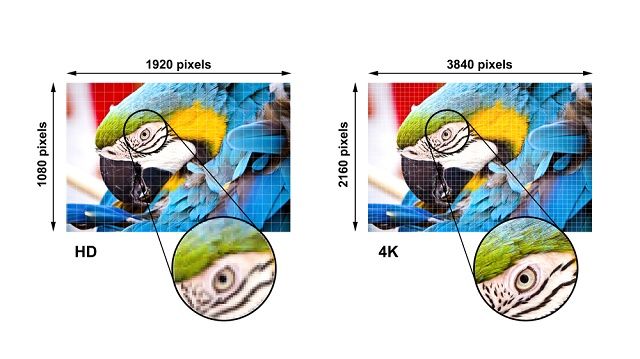Difference Entre Tv Uhd Et 4k
If you're in the market for a new TV, you're probably thinking about getting a 4K or Ultra Hard disk model. Is there a difference, and what exactly should you be looking for when you buy? Here's what you demand to know before diving in.
What Do the "Ultra HD" and "4K" Labels Mean?
Let'due south start past defining "Hard disk drive." High Definition Tv (HDTV) is the standard that's been in use for over a decade, and you'll find it difficult to buy a Telly that isn't at least "HD Ready," which ways capable of displaying at a resolution of 1280x720 (720p).
Well-nigh modern TVs are at least "Full Hard disk drive," which ways capable of displaying at a resolution of 1920x1080 (1080p).
The "p" stands for "progressive," significant that the entire image is fatigued each frame. The culling is "i" for "interlaced" (as in 1080i, some other HDTV standard), meaning odd and fifty-fifty lines are displayed in alternating frames. This results in a lower quality picture show.
Forth those lines, the term 4K refers to any display format with a horizontal resolution of approximately iv,000 pixels. This is slightly confusing as Television receiver resolutions, at least upwardly until this betoken, take generally been referred to past the number of vertical pixels. TVs with this many pixels are "Ultra Hard disk drive," or UHD for brusk.

This switch isn't entirely capricious. Different TVs, digital pic theater standards have traditionally emphasized horizontal resolution. The Digital Cinema Initiatives (DCI) standard is the most mutual for digital production and mandates a resolution of 4096x2160.
4K vs. UHD vs. 2160p
UHD-1 is the closest TV display standard to the DCI standard and refers to a resolution of 3840x2160. This resolution is four times the pixel count of Full HD. Virtually mod TV displays are UHD-i as the wider aspect ratio of DCI 4K is non suitable for most Television receiver content. However, they are both almost universally referred to every bit 4K.
UHD-1 is ofttimes referred to as 4K UHD or just 4K. Some people occasionally refer to UHD-1 as 2160p. When you come across whatever of these terms, they typically mean the same thing. When it comes to TVs, in that location is no departure between 4K and UHD.
Note:There is besides Full Ultra HD, sometimes chosen 8K, which refers to a resolution of 7620x4320. This is quadruple the pixels of 4K and xvi times larger than Full Hd. But 8K is yet in a relatively infantile stage. For the virtually part, when you see the Ultra Hd characterization on a Blu-Ray flick or elsewhere, you tin take it to be referring to 4K.
Tin can You Observe the Difference Between HD and UHD?

While the content situation has improved, most people probably won't observe the higher resolution even when watching native 4K content.
If you're sitting less than six feet away from a 55-inch TV and you have perfect vision, y'all might notice a difference. At greater distances, smaller screen sizes, or less clear eyesight, you probably won't. In about circumstances, the difference is marginal and may not exist worth the toll of upgrading.
Nonetheless at that place may be other valid reasons to make the upgrade. The college resolution may not benefit y'all much, merely there are other features of UHD TVs that may persuade you. Not all UHD TVs have them, however, and so it's important to tread carefully.
Ultra Hard disk Premium
The new Ultra HD Premium standard specifies increased color depth (over a billion colors) and a college dynamic range and then the quality of the flick should exist noticeable compared to prior standards.
The Ultra HD Premium logo is a guarantee that the device meets the standards and is able to brandish UHD content as it's meant to exist seen. Manufacturers like LG, Panasonic, and Samsung have embraced the Ultra HD Premium standard. So have content providers like Netflix, Warner Bros, and 20th Century Pull a fast one on.

Sony doesn't utilize the logo even though it was part of the UHD Brotherhood that adult information technology, only many of its TVs meet or exceed the required specifications.
Do You Need a 4K or Ultra HD TV?
4K content tin can stream to a 1080p Goggle box. Ultra HD Blu-Ray disks play on older televisions. The latest generation of video game consoles will piece of work besides. If you already have a TV, y'all tin continue to utilize that TV and still view whatever you want.
Ask yourself if 1080p looks insufficient. If you think HD content all the same looks beautiful, you lot may do well to save your coin. Most content is still made with 1080p displays in mind. And you won't be doing yourself any favors buying a 4K TV if yous primarily picket DVDs, which max out at 480p.
But there are reasons to desire an UHD TV. If you take a home theater room where you're seated further back from the screen, or y'all're in the market place for a new Television regardless, it makes sense to go for 4K. If yous enjoy playing games at their maximum resolution, that will before long mean getting a 4K Idiot box. Y'all can even get a 4K Television for under $600.
A Few Other Points to Consider
If you do take the plunge and care for yourself to a new UHD Tv, you may need to brand some other upgrades to become the nigh out of information technology. Your existing devices, cables, and services will all withal work merely they may not allow you to view UHD-quality pictures.
While HD content that's been upscaled to UHD will expect fine, the visual quality is not on part with content natively produced in UHD.
That ways to experience 4K you volition have to practise more than get a new TV. Here are other changes you lot may need to brand:
- You will need fast reliable broadband. 4K content requires more bandwidth than HD.
- You may need to change your cable or satellite subscription plan to get access to UHD content. It volition probably cost more.
- Your quondam Blu-Ray player will also need replacing. UHD Blu-Ray players will upscale existing 1080p Blu-Rays as well as play the higher resolution (and more expensive) UHD discs.
- You may desire a new HDMI cable. While HDMI one.4 is capable of displaying UHD resolutions, HDMI ii.0 is needed to display them at lx frames per second.
Streaming platforms similar Netflix, Hulu, Amazon Prime, and Disney+ all accept growing catalogs of UHD content. To have advantage of this, you lot'll demand a streaming device that tin handle UHD (unless your TV comes with these services born).
Hither is our head-to-head comparison of four of the best 4K streaming devices on the market place.
Difference Entre Tv Uhd Et 4k,
Source: https://www.makeuseof.com/tag/whats-difference-4k-ultra-hd/
Posted by: baumobee1968.blogspot.com


0 Response to "Difference Entre Tv Uhd Et 4k"
Post a Comment